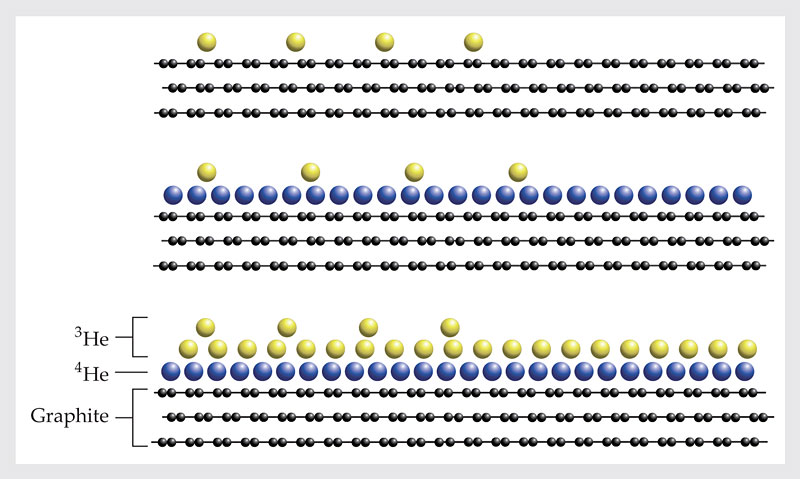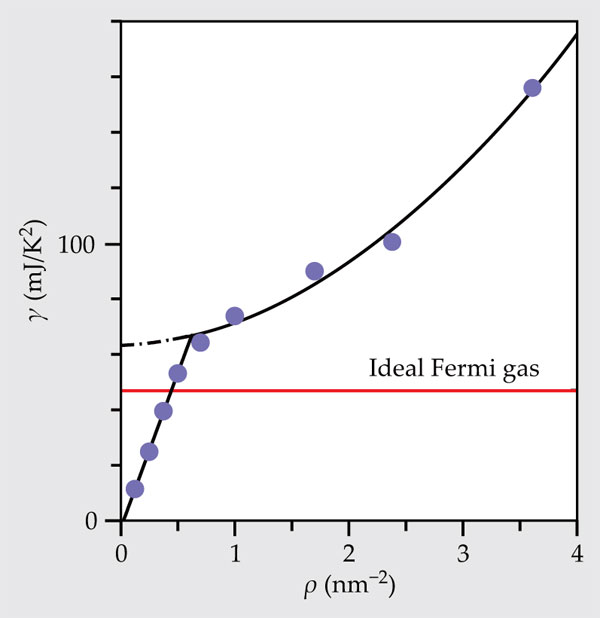A liquid ground state for 2D helium-3?
DOI: 10.1063/PT.3.1842
Because helium-3 is so light, and because, as a fermion, it can’t crowd into low energy levels, ensembles of 3He atoms have unusually large kinetic energy in the ground state. When that energy is partitioned among two dimensions instead of three, it’s thought to be sufficient to overcome van der Waals attractions and prevent the system from condensing into a 2D liquid—even at absolute zero.
It came as a surprise, then, when in a 1985 experiment
1
by Bidyut Bhattacharyya and Francis Gasparini (State University of New York at Buffalo) 3He appeared to form a quasi-2D liquid. The researchers had added 3He to a thin film of 4He and chilled the mixture to millikelvin temperatures. In such a system, the 3He atoms strongly prefer to sit at the film’s surface, and because 4He becomes a superfluid, they can move about that surface almost as easily as they would in free space. (See the article by Robert Hallock, Physics Today, June 1998, page 30
The heat capacity of such a weakly interacting 2D group of fermions is known to grow linearly with temperature. The slope, γ, can be shown to be proportional to the atomic mass and the occupied surface area—but independent of the total number of atoms. But Bhattacharyya and Gasparini found that under certain conditions, γ grew as 3He atoms were added. The only reasonable interpretation, they concluded, was that 3He atoms weren’t spreading out over the entire film surface, as a gas would, but instead were collecting into puddles of fixed, low density that occupied a growing fraction of the film surface as atoms were added.
The Buffalo team’s finding runs counter to nearly five decades of theoretical and numerical work on 2D quantum systems. And subsequent experiments have only muddied the picture: Work by Moses Chan’s group at the Pennsylvania State University seemingly corroborated the results, but a later study by Hallock and colleagues at the University of Massachusetts Amherst found no signs of a liquid phase.
Some theorists speculate that the surface of a thin film just doesn’t suitably approximate a 2D environment. Surely, atoms at the free surface retain some freedom to move in the normal direction, and such imperfect confinement should effectively reduce the atoms’ ground state energy in the plane of interest. Furthermore, the superfluid film used in the experiment might have hosted ripple-like quantum excitations, or ripplons, which could mediate interatomic interactions not appearing in theoretical models.
Now, work from a University of Tokyo team led by Hiroshi Fukuyama may dispel notions that the apparent liquid phase is an artifact of hydrodynamic or 3D effects. 2 Their new experiments seem to show that the precise nature of the underlying film has little bearing on whether or not 3He condenses.
Flat liquid
The Tokyo group’s recent work grew out of previous efforts to elucidate how magnetically disordered systems known as spin liquids transform to ferromagnetic states. Fukuyama and his colleagues sought to re-create such a transformation in the lab by gradually increasing the density of a 3He monolayer adsorbed on graphite. Before the transition occurred, however, some 3He atoms leapt out of the densely packed monolayer to form a new top layer. Those atoms seemed to form puddles much like the ones observed in the Buffalo experiment.
Figuring that the appearance of the liquid phase was probably connected to the atoms’ out-of-plane motions, Fukuyama, Tomohiro Matsui, and graduate students Daisuke Sato and Kimiaki Naruse decided to probe 3He’s behavior in the three different quasi-2D systems depicted in figure 1. In one case (top image in figure), the 3He layer of interest was adsorbed directly onto a graphite substrate; in a second (center), it was deposited on a dense monolayer of 4He; in a third (bottom), it was deposited atop two dense monolayers—a layer of 3He overlying a layer of 4He. The 4He monolayers serve to mitigate the effects of surface heterogeneities.

Figure 1. Mimicking two dimensions. When chilled to millikelvin temperatures, helium-3 atoms atop a graphite substrate (top), a dense 4He monolayer (center), or dense 4He and 3He monolayers (bottom) closely approximate a 2D quantum fluid. In the multilayer films, the bottom monolayer of 4He serves to mitigate the effects of heterogeneities in the graphite substrate. (Adapted from ref.

Each system imposes varying degrees of 2D confinement on the topmost 3He atoms: Those adsorbed directly onto graphite have the least freedom to move normal to the plane, whereas those sitting atop two monolayers have the most. So if the purported liquid phase was indeed an artifact of out-of-plane motion, the Tokyo group should have seen quantitative differences in the phase behavior of the three systems, and perhaps no liquid phase at all for 3He deposited directly on the graphite substrate. Because the underlying monolayers in both multilayer films behave as 2D solids, ripplons shouldn’t factor into any of the three scenarios.
To the team’s surprise, calorimetric data obtained at temperatures of 80 mK and below were quite similar for all three systems. Figure 2 shows representative results obtained from 3He atop a single layer of 4He: As in the Buffalo experiment, γ grows proportionally to the average areal density ρ—the number of surface atoms per unit area of substrate—at small ρ. And as in the Buffalo experiment, that linear-growth region is thought to signal puddle formation. Notably, the linear trend can be extrapolated to the origin, which suggests that the liquid phase is stable in the infinitely dilute limit.

Figure 2. Calorimetric data for ultracold helium-3 atop a dense 4He monolayer show signatures of a liquid phase: At low coverage densities, γ—the slope of the heat capacity as a function of temperature—grows linearly with the average coverage density ρ. In that regime, 3He collects into liquid puddles of fixed, low density. Above the critical density of ρ ≈ 0.6 nm−2, at which the puddles presumably cover the entire substrate surface area, γ grows nonlinearly, indicating strengthening atomic interactions. Extrapolated to ρ = 0 (dot–dash line), the nonlinear branch yields a γ that’s roughly 25% larger than the ideal Fermi gas value, indicated by the red line. (Adapted from ref.

The researchers infer from their data that the areal density inside the puddles lies roughly in the range of 0.6–0.9 nm−2. That would make it the lowest-density liquid ever discovered in nature, with a mean interatomic spacing of more than a nanometer, more than twice that of 3D 3He.
Implied interactions
Fukuyama isn’t yet sure how to reconcile the experiments with theory, but the data in figure 2 may hold an important clue. They show that at a critical average density, γ shifts from a linear function of ρ to a nonlinear one. Presumably, that density marks the point at which liquid 3He covers the entire substrate surface, and the nonlinear behavior reflects strengthening atomic interactions as the liquid becomes more densely packed.
Extrapolating the nonlinear branch to ρ = 0 should, in theory, yield γ corresponding to an ideal, noninteracting Fermi gas. The actual value, however, is roughly 25% larger. The implication is that there must be some as-yet unidentified interaction—possibly mediated by quasiparticles—that drives condensation.
Washington State University theorist Michael Miller thinks there may be a simpler answer: The Tokyo group may be seeing not condensation but aggregation, driven by preferential adsorption at heterogeneities in the graphite substrate. “If it turns out that this can’t be explained away in terms of surface inhomogeneities,” Miller comments, “then something very strange has to be going on.”
A key next step for the Tokyo group will be to determine the critical temperature at which the 2D liquid transitions to a pure gas. That temperature is expected to lie somewhere in the range of 80–700 mK. To pinpoint it, Fukuyama and his colleagues will need to do some tinkering with their calorimeter: It currently relies on a superconducting zinc heat switch that fails at temperatures above 80 mK.
Theorists will have plenty to mull over in the meantime. In the opinion of Gasparini, “One might say the score is now three experiments in favor of a 2D liquid phase and one against it.”
References
1. B. K. Bhattacharyya, F. M. Gasparini, Phys. Rev. B 31, 2719 (1985). https://doi.org/10.1103/PhysRevB.31.2719
2. D. Sato, K. Naruse, T. Matsui, H. Fukuyama, Phys. Rev. Lett. 109, 235306 (2012). https://doi.org/10.1103/PhysRevLett.109.235306
